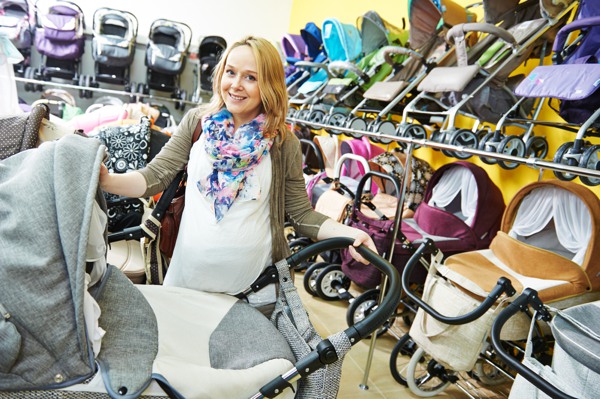 Congratulations on your pregnancy. You are now well on the way to a life time of both joy and heartache, smiles and tears. One thing is certain, and that is that children can cost a lot of money. According to Guardian Money, the average new mother spends around £1,000 on items for new-borns, with pushchairs and cots often being the biggest expense. In addition, the Money Advice Service has previously stated that the average cost of a child in their first year is around £4,000!
Congratulations on your pregnancy. You are now well on the way to a life time of both joy and heartache, smiles and tears. One thing is certain, and that is that children can cost a lot of money. According to Guardian Money, the average new mother spends around £1,000 on items for new-borns, with pushchairs and cots often being the biggest expense. In addition, the Money Advice Service has previously stated that the average cost of a child in their first year is around £4,000!
With that in mind, it’s worth spending some time thinking about the items you will need to buy before your baby is born. That’s why we have put together a list of products for you to consider. Some are considered essential, whereas others are there to make your life easier. We have outlined the benefits of the products so you can decide whether or not you think you need them.
In this guide:
- Prams, Pushchairs, and Travel Systems
- Car Seats
- Moses Baskets, Cribs, Co-Sleepers, and Cots
- Baby Baths
- Baby Blankets and Sleeping Bags
- Muslin Squares
- Breast Pumps
- Bottle Feeding
- Sterilisers
- Bouncing Chairs / Rockers
- Teething Toys
- Thermometers
- Changing Tables and Mats
- Baby Slings, Front Carriers and Back Carriers
- Activity Mats / Baby Gyms
- Baby Mobiles
- Baby Swing Chair
Prams, Pushchairs, & Travel Systems
In the first few months of their life, your baby is likely to spend a great deal of time in his or her pram or pushchair. Prams and pushchairs provide a cosy space for your little one to travel in as you visit the shops, take a walk in the countryside, or visit friends.
When it comes to choosing a pram or a pushchair, it can be a mind-boggling experience as there are so many different options available, from simple pushchairs to multi-part travel systems. So, how do you choose? One thing you will definitely need to remember is that until your baby can support his or her own head comfortably (around 4 months), he or she will need to lie flat, and therefore, some pushchairs might not be suitable.
The size of the boot of your car is another thing that you will need to consider when choosing your pram or pushchair. Whilst some fold down to a fairly small size, others are unlikely to fit in a compact three-door hatchback. You will also need to think about your own lifestyle. Are you an outdoor adventurer or do you prefer the comforts of a shopping centre? An all-terrain three-wheeler pushchair is excellent for navigating rough terrain, but it’s not so good at turning round the tight corners of clothing rails in shops.
Prams
 Prams have developed considerably from the vintage coach built prams that were popular in years gone by. Prams are excellent for new-borns as they allow babies to lie flat in a protective surround, keeping them warm and snug. With most prams, your baby faces you so he or she always knows you are there, and most also have the ability to later convert into a pushchair ideal for toddlers. However, they are less compact than pushchairs, and if you have small boot you may struggle for space.
Prams have developed considerably from the vintage coach built prams that were popular in years gone by. Prams are excellent for new-borns as they allow babies to lie flat in a protective surround, keeping them warm and snug. With most prams, your baby faces you so he or she always knows you are there, and most also have the ability to later convert into a pushchair ideal for toddlers. However, they are less compact than pushchairs, and if you have small boot you may struggle for space.
Pushchairs

Pushchairs are lightweight and generally fold down to a fairly compact size, making them ideal for smaller cars and for trips around the shops. Some are suitable from birth with the option to lay the back flat, although they do not offer the same level of comfort and protection as a pram. Pushchairs tend to be less expensive, so are ideal if you are on a budget. All of the pushchairs listed below are suitable from birth.
Travel Systems

Travel systems incorporate a pram with a carrycot and / or a car seat, allowing you to easily transport your baby around from outdoors to indoors without disturbing them. One thing to remember when considering a travel system is that research has shown that very young babies who spend large amounts of time in a car seat can develop problems with their posture and with their lung function. Most experts recommend that a baby is taken out of a car seat every two hours and laid flat for a period of time.
All Terrain Pushchairs

All terrain pushchairs give you the freedom to explore the great outdoors with your baby. They have inflatable tyres and suspension giving your baby extra comfort over rough terrain. However, the tyres are prone to punctures and we would recommend using a slime bike tyre sealant to avoid any unwanted problems when you are far from home. These pushchairs are not very compact, and they can be difficult to manoeuvre around the shops, as they are generally wider and longer than other prams and pushchairs.
Double Pushchairs

If you are expecting twins or have a young toddler with a second baby on the way then you will probably need a double pushchair. Double pushchairs come with three different options for seating:
- Both children sat side by side – These tend be quite wide and some brands can be difficult to manoeuvre.
- One child sat behind the other
- One child sat underneath the other – This type and the type above where one child is sat behind are referred to as Tandem Pushchairs and are generally longer and less compact when folded down. The child underneath or behind may also struggle for legroom as he or she grows.
Not all double pushchairs will be suitable for twins, as they may have only one seat that lies flat so this is worth remembering when you are shopping around.
Car Seats

In 2006 the UK government introduced new laws about the use of car seats for children in cars. The law now states that all children must use a car seat that is appropriate to their height or weight until they either reach 12 years of age or become 135 cm in height, whichever of the two comes first.
To complicate matters further, additional legislation was introduced in the UK in April 2015 that introduced the European i-size compliance to the UK. I-size compliance has all babies sitting in rear-facing car seats (i.e. with their backs towards the driver) until they are 15 months old. Currently, this i-size compliant legislation sits alongside the 2006 legislation that has babies in compulsory rear facing seats until they are 9kg. It is anticipated that the i-size legislation will replace the 2006 legislation completely around 2018, giving manufacturers and parents enough time to make the switch.
The reason for this change is that it has been proven time and time again to be much safer for young children to be in rear-facing car seats when involved in accidents. In many European countries, particularly Scandinavia, children stay in rear-facing car seats until they are around four years old for this very reason and these countries have a much lower fatality rate for children in this age group involved in car accidents.
The law also states a child must travel in a car seat even if there is an unexpected journey if they are under three years of age. Over three years and a child can travel without a car seat if the journey can be demonstrated to be unexpected, necessary and of a short distance, i.e. in an emergency. The only exception is in a taxi or licenced mini cab where a seat is not necessary, although one is recommended.
Rear facing car seats must not be placed in the front passenger seat if there is an active airbag. Forward facing car seats can be placed in the front passenger seat, although this is not recommended. Statistically, the safest place for your child’s car seat is in the rear seat behind the front passenger seat. Unless you can be 100% certain of the history of a car seat, we recommend that you never buy one second hand. This is because the safety of the seat may have been compromised through a previous accident with unseen damage that can affect the seat’s integrity.
Moses Baskets, Cribs, Co-Sleepers, and Cots
Though it might not feel like it in between the feedings, nappy changes, and periods of crying, a typical new-born baby will spend around 16 hours a day asleep. That will gradually reduce to around 13-14 hours by the time they are one year old. Sleep is important to your baby’s physical and mental development, and whilst most babies will generally prefer to sleep in mum or dad’s arms, a safe, cosy space is needed in order to make sure that you as parents also get some rest.
Around the world, babies of different cultures sleep in all sorts of places, from one big family bed in many Asian countries, to a cardboard box that comes pre-packed with baby clothes and accessories from the government in Finland. In the UK, babies tend to sleep in a Moses Basket or a Crib for the first few months, before later moving into a cot.
Many parents are fearful of Sudden Infant Death Syndrome (SIDS), also known as cot death. Thankfully, this is extremely rare and there are steps you can take to reduce the risk further. These include:
- Putting your baby to sleep on their back
- Having your baby sleep in the same room as you
- Avoid anyone smoking around your baby
- Avoid sharing a bed with your baby if you are under the influence of drugs or alcohol
- Never fall asleep with your baby on a sofa or a chair
- Don’t allow your baby to overheat
The following products provide safe and comfortable places for your baby to sleep:
Moses Baskets

Moses Baskets, named after the biblical tale of Moses who was put in a basket by his mother and placed on the river Nile to save him from the Egyptian pharaoh, are lightweight and often come with handles that enable you to move the basket easily between rooms. Most Moses Baskets come with their own bedding and mattress, providing an all in one sleeping solution. They are really only suitable for about the first three months of your baby’s life, but they help the baby to feel safe and secure in a cosy environment.
Cribs

Cribs are heavier than Moses Baskets being made out of wood, and do not have the same level of portability. However, most come with the ability to rock your baby, helping them to sleep.
Cribs are smaller than cots so new-borns may find them much cosier to sleep in, and this also means you can usually fit them in your own bedroom easily.
Co-Sleepers

Many parents wish to sleep close to their babies but are fearful about the risks of SIDS. Co-sleepers provide a safe way of allowing you to sleep with your baby whilst reducing this risk. In addition, if you’ve had surgery following labour a co-sleeper allows you to easily pick up your baby for feeding without you needing to leave your bed. Most can easily be fitted securely to your bed and transformed into a crib if required.
Cots

Most babies are between three to six months old before they sleep in a cot. Therefore, if you are planning on using a Moses Basket, Crib, or Co Sleeper first, then there is no hurry to go out and buy a cot before your baby is born. This is because new-borns don’t feel comfortable in something as spacious as a cot. After all, they’ve spent the first nine months of their lives nestled in your tummy so when they join us in the big wide world they feel safest when they are snug and cosy.
Once it is time to buy a cot it’s worth considering investing in a cot-bed. Cot-beds are longer than standard cots and so may not be ideal for placing in your own room if space is an issue, but they do convert into a toddler bed that your child will be able to sleep in until they are around four years of age. Look for a cot with an adjustable mattress level – your baby can sleep at a higher level whilst they are still unable to roll over or sit up, so you can save your back from a lot of bending over to pick them up.
Baby Bath

Giving your baby a warm bath before bedtime can help them to relax and if you use it as part of a bedtime routine it can help establish a sleeping pattern. A baby bath gives you flexibility at bath time. It saves you having to bend over a bathtub, and you can use it in another room if it’s more convenient or if your bathroom is particularly cold.
Remember, new-borns become cold quickly, so don’t keep them in the bath too long. You don’t need lots of bath products either. Water is just fine in the early days and even the most popular baby bath products can dry out your baby’s delicate skin.
Baby baths can be a simple oval shaped tub, or more complex with toys, a plughole, and even the ability to attach to the top of a regular bathtub. Some now come shaped more like a bucket, designed to let your new-born sit in a foetal position with the water coming up to their shoulders, mimicking the feeling of being in the womb. What you choose is up to you, though remember, your baby will quickly outgrow the baby bath and will soon be in the regular bathtub, so you may not want to spend too much money on one.
Baby Blankets and Sleeping Bags
Once you have chosen a crib or a Moses basket you will need some bedding for your baby. You can either choose a traditional blanket, or a baby sleeping bag. You shouldn’t use duvets and pillows for your baby until they are one year old, as there is a suffocation risk.
Blankets
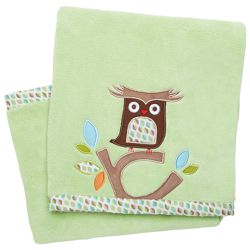
Blankets are useful because you can add or take away layers as you need depending on the temperature of the room. Your baby’s hands and feet are not a good indicator of their temperature, instead you should feel around his or her neck or tummy to see if you need to add or take away any layers. It’s also a good idea to have a few spares in case your baby is sick or you have a nappy leak.
Blankets also enable you to swaddle your baby. Swaddling is where you wrap your baby up in a blanket keeping their arms tucked in. It mimics the feel of a womb and helps your baby feel more secure.
Sleeping Bags
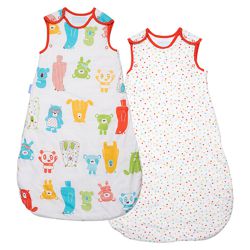
Sleeping bags have become a popular alternative to traditional blankets in recent years, as wriggling babies are unable to kick them off, thus keeping them warm throughout the night. When buying a sleeping bag it’s important to get the right size for your baby and to make sure that he or she cannot slip their head under the neck opening. For this reason, most sleeping bags are not suitable for newborn babies, as the neck opening tends to be a bit too big.
Like duvets, sleeping bags come with a tog rating. Many brands of sleeping bags come with a room thermometer and a guide to what tog rating should be worn according to the temperature, but as a general rule the following applies:
- 2.5 tog: 16 – 20°C
- 1.0 tog: 21 – 23°C
- 0.5 tog: 24-27°C
Higher tog ratings are available and if you have a poorly heated house in the winter with temperatures regularly dipping below 15 degrees you may wish to consider one of these.
Muslin Squares
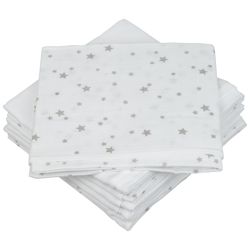
Muslin Squares may seem like inconspicuous pieces of cloth, but to many Mums they are a secret weapon. Primarily used to mop up baby-spit ups after feeds, they have plenty of other uses as well, including:
- Aiding discreet breastfeeding
- Security blanket
- Replacement sunshade in the car or the pram if needed
- Lining public changing tables
- Protecting your own clothes against baby spit up and drool
- Alternative bib during weaning
It’s little wonder that they are a staple of changing bags around the country, and once your baby has finished with them they make great household cleaning cloths, as well. Most come in multi-packs and many are colourfully decorated.
Breast Pumps

If you are planning on breast-feeding then a breast pump is a useful addition to your baby product list. Breast pumps allow you to express breast milk into a bottle for use later on. There are a number of reasons why you might need to do this. Your newborn baby might be tongue-tied. This is when there is a piece of skin attaching your baby’s tongue to the bottom of the mouth.
It’s thought that around 3% of babies have this condition and babies that do so often find it difficult to latch onto their mother’s breast, making feeding impossible. Other reasons include your baby requiring to spend time in a neo-natal unit and needing a feeding tube. In this case, most hospitals will supply you with a breast pump to borrow.
Alternatively, you may wish to use a pump to provide milk for when you are not around, or to let your partner take a turn in feeding your newborn. Expressing milk can also help with building your natural supply and give your nipples a break if you develop mastitis, which is an inflammation of breast tissue that can become infectious.
There are two types of pumps; manual and electric. Electric pumps are quicker and more efficient. They also latch onto your breast leaving your hands free. However, they can be noisy and quite clunky so are not ideal for transporting around. They are also quite expensive. Manual pumps require a lot more effort on your part, but they do fit nicely into a changing bag and are a lot cheaper to buy.
Bottle Feeding & Sterilisers
Breast milk has been proven time and time again to be the best source of milk for your baby. However, it is important to recognise that not every Mum is able or inclined to breast-feed and, therefore, formula can provide a healthy alternative.
If you are formula feeding you will need to invest in a set of bottles, teats, and a steriliser. It’s important to sterilise your baby’s bottles and teats in the first year of their life as their immune system is still developing and they are more at risk of picking up infections. Of course, as any Mum knows, it’s impossible to keep babies within a completely sterile environment, and once they start crawling around, they are likely to put all manner of objects into their mouths. However, sterilising reduces the risk of infection and, therefore, it’s a good idea to keep sterilising bottles and teats (and dummies) until your baby is around one year old.
Bottles

Most brands of bottles have teats that only fit that specific brand, so this is something to remember when choosing bottles for your baby. Some bottles have anti-colic systems that may help if you have a particularly colicky baby.
Teats tend to have varied speeds (i.e. the amount of milk that comes out at once). Choose the lowest speed of teat for your newborn, and then change to a higher speed teat as they grow (typically around 3 months and then again at six months). Some parents note that their baby started to seem more tired during feedings and uninterested in the bottle before they changed to a faster teat, as though the slower teat was becoming too much effort.
Whilst you can buy individual bottles, it’s a good idea to get a set, so you do not always have to wash and sterilise between each feed. This is particularly useful when your baby is younger, as they may feed every two to three hours.
Sterilisers
There are several ways you can sterilise your baby’s bottles:
Cold Water Sterilising Tablets

These are tablets that you place into a tub of cold water. The tablets dissolve and you can place your bottles, teats, etc. into the tub. Sterilising takes around 15 minutes and you can put items in and out of the tub for 24-hours before you need to change the water. This is a fairly cost effective way of sterilising. You don’t need to buy a special tub, although you can find them in the shops.
A large plastic container or bucket with a lid works just as well and the tablets themselves are just a few pounds available from most supermarkets and baby shops. The downside of this is that you need to be organised to have a bottle ready in the middle of the night when your baby wakes for a feed.
Microwave Sterilisers
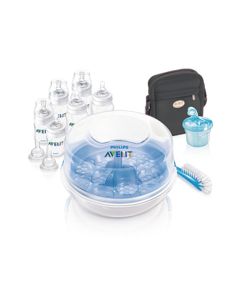
Microwave sterilisers are plastic tubs that you fill with a small amount of water. Place the bottles in the tub and close the lid. Then place in the microwave for however long the instructions state (usually around 3-minutes). The steam generated from the water sterilises the items within the tub.
The benefit of these is that you can quickly sterilise a bottle, which is handy in the middle of the night. Most also come as a set with bottles, so you don’t have to buy them separately. However, they are only portable if you are travelling to somewhere where there is a microwave, and they can be quite large, so may not fit in your microwave if it is particularly small.
Electric Steam Sterilisers

Electric Steam Sterilisers are standalone units that do the same as a microwave steriliser, i.e. they use steam to sterilise the items. They take a few minutes more than microwaves, but are useful alternatives if you don’t have a microwave or if your microwave is too small to fit a steriliser. As with many of the microwave sterilisers, electric steam sterilisers tend to come as part of a set with bottles and teats included. On the flip side, they are generally more expensive than a microwave steamer.
Buy Electric Steam Sterilisers
Bouncing Chair / Rocker

Your baby will spend a great deal of time observing the world around them, taking it all in and learning about themselves and their family. Bouncing Chairs, or Rockers, are a great way of giving your baby an alternative view of their surroundings. They also give your arms a rest and provide a safe space for you to place your baby.
Most are brightly coloured, which appeals to young babies whilst their eyesight develops. Most also include an activity bar with toys that hover over your baby giving them something to focus on and to try and reach out to, helping them to develop their hand and eye coordination.
Some also include a vibration setting and all can be rocked or bounced which may help soothe your baby to sleep. Rockers are more expensive than bouncers with solid frames and more features such as extra padding. When choosing a rocker or a bouncing chair make sure it’s one where the cover can be easily removed and machine-washed.
Teething Toys
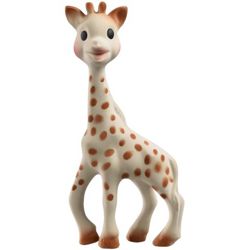
Mention the word “teething” to a parent of a baby and you are likely to see them wince or shudder. Teething is a difficult, stressful time for both you and your baby. Your baby will often be in pain as the teeth push through, and their sleep is likely to be disturbed, meaning less sleep for you too. Many parents report that their babies also suffer with diarrhoea during teething, thought to be as a result of the extra saliva that is generated.
There are many ways that you can help soothe your baby’s pain. Some parents find teething gels and granules to be effective, others find that only baby paracetamol works. During the teething process your baby will probably want to gnaw on something to relieve the tension, and teething toys provide a safe way for them to do this. They can also help distract your baby from the pain.
Most teething toys are brightly coloured, some make noises and some have various attachments that can be pulled or tugged, helping to entertain your baby. Many can be placed in the fridge or freezer – the coldness of the toy can help sooth sore mouths further. Teething toys are not very expensive and make great gifts for babies. You may wish to choose one that is marked as Bisphenol A (BPA) free. BPA is a chemical that is widely used in plastics and there is some evidence linking its use to cancer and other serious conditions.
Buy Teething Toys | Sophie the Giraffe
Thermometers

Your baby is almost guaranteed to experience a fever in the first few months of his or her life. This can be a scary time for new parents, but it is the body’s natural way of fighting off infection. Most babies have an average temperature of 36.4C. The NHS considers a fever to be anything over 37.5C. Many babies will experience a fever after their vaccinations and this is normal. If your baby has other signs of illness you may wish to contact a doctor. The NHS also advices that you immediately contact a doctor if your baby is under three months old and has a temperature above 38C or is between three and six months old and has a temperature above 39C.
Having a thermometer available that you can use to take your baby’s temperature can give you peace of mind and help you to decide if you need to seek medical help. A digital thermometer gives you an accurate reading and they are relatively simple to use. The NHS does not recommend using a strip thermometer placed on the skin, as this tends to take the skin temperature rather than the body temperature.
There are a variety of thermometers on the market. Stick thermometers have a tip on the end that you place in your baby’s armpit to take a reading. Your baby needs to remain still whilst it is being used. Digital ear thermometers are popular amongst health professionals and provide a quick reading, but many require disposable covers for the tips and the readings can be inaccurate if not used in the correct position. They are also not suitable for newborn babies, as their ear canals are too small. Infrared thermometers work without needing to touch your baby and provide an accurate reading, but they are quite expensive.
Changing Tables and Mats
You will spend a lot of time over the next couple of years changing nappies. It’s been estimated that babies go through around 4,500 nappy changes before they are potty trained. Whilst many of those changes will take place at supermarket toilets, nurseries, and even the back seat of your car, it’s useful to have a place in your home where you can have everything you need available to change your baby. A changing table allows you to have just that, whilst a changing mat provides a padded washable cushion for your baby to lie on.
Changing Tables

Some parents argue that a changing table is not very useful, as it’s easier to have a few changing mats around the house that you can just use on the floor. However, if you are recovering from a C-section or suffer from back problems, you may want to avoid all the extra bending and a table will enable you to do so.
Furthermore, most changing tables come with drawers or shelves where you can store nappies, wipes, lotions, etc. Some can have the top removed to be converted into a regular chest of drawers or shelving unit later on. Alternatively, you can get a tray shaped unit that sits on top of your baby’s cot, and this provides a cheaper alternative.
Changing Mats

Changing mats are padded cushions coated with PVC so that you can easily wipe them clean. They tend to be of a standard size so most changing mats will fit most changing tables. You can also use them on the floor and they are very lightweight so are easily transported around. In addition, you can buy special changing mats that fold up to use in your bag or for travelling. They are also quite cheap to buy, and some parents recommend having one upstairs and one downstairs to save taking your baby up and down the stairs each time they require a nappy change.
Baby Slings, Front Carriers, and Back Carriers
Baby slings and carriers are not essential items, but they are a good added extra. They allow you to free up your hands so you can easily do the shopping, hold onto older children, or do jobs around the house. Many babies enjoy being held close to their Mums in a sling and the rocking motion from walking around can help them to go to sleep.
Slings
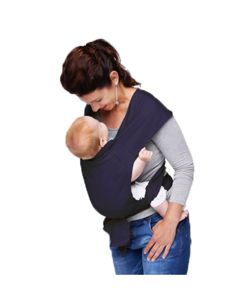
Slings usually consist of a piece of fabric that can be wrapped around you and your baby in a variety of ways depending on the age and size of your baby. They can be used from birth as they have the option to put your newborn into a cradling position and some can be used well into toddlerhood with your toddler held onto your hip. Many enable you to breastfeed discreetly and they are lightweight and pack down very small. They can be better for women with back problems than other carriers.
Front Carriers

Front carriers tend to vary in price much more than slings and include additional safety buckles. However, some can only be used for the first few months of your baby’s life and they can put extra strain on your back because of the way the baby is positioned. Many are not suitable for newborns and you have to wait a few weeks before you can use one with your baby. Most have two seating positions with your baby either facing you or away from you when they are older. Some can even be converted into a back carrier for your toddler, extending their usefulness.
Back Carriers

Back carriers are popular amongst parents who like being in the great outdoors. They are generally suitable for babies who are six-months and older, and tend to be much more bulky than front carriers and slings. Many have accessories such as storage space, rain and sun covers, and detachable backpacks.
They are not particularly useful around the house thanks to their size, and they can put a lot of strain on your back, but some can carry toddlers up to four years old and they provide a great way of exploring footpaths that are perhaps unsuitable for pushchairs and little legs. They tend to have a much higher starting price than slings and front carriers.
Activity Mats / Baby Gyms

Brightly coloured, often with interactive features, activity mats keep your little one busy and help develop their hand and eye coordination. Ranging from simple mats with different colours and textures to elaborate baby gyms with toys hanging from arches and noise and light making accessories. Whilst not an essential item, activity mats and gyms do provide a place of entertainment and distraction for your baby, giving you a few minutes to relax or carry out a household task. Mats are also a great way of introducing your child to tummy time.
Giving your baby time lying on his or her tummy each day is important for physical development, as it encourages them to try and push up, necessary for learning to crawl. Many babies dislike tummy time and will cry as soon as they are placed in that position, so giving them a mat to lie on with lots of bright colours can be a useful distraction. Make sure you choose one that is machine washable, and if choosing a gym with arches and hanging toys, consider getting some extra link rings to make sure all the toys are within your baby’s reach.
Baby Mobiles

Your baby will be unable to roll over for the first four to six months of his or her life and, therefore, will spend a great deal of time lying on their back. Mobiles are a great way of providing stimulation to your baby during this time, and they can also help sooth a baby to sleep. In the past, mobiles were lightweight decorative pieces that hung from the ceiling, whereas today the most popular mobiles attach directly to your baby’s cot and many play music and have light effects. Some parents like to put their babies in the cot with the mobile switched on whilst they have a shower, other parents attach the mobile to the side of the changing table as they find having a distracted baby makes changing a nappy much easier. So, whilst they are not essential, they do have some great benefits.
When choosing a mobile, make sure that your cot or crib can support it properly and securely. When your baby is able to push themselves up and / or roll over you will need to remove the mobile from the cot as they may hit their head on the fastenings or worse still become entangled in them. In addition, consider whether or not you want to have additional features, such as a night-light or a music box. Given that mobiles can only be used for a few months you probably do not want to spend money on extra features you are unlikely to use.
Baby Swing Chair

If your baby suffers from colic, reflux, or will only fall asleep by being gently rocked, then a baby swing chair may be for you. The automated rocking motion provided by chair can bring welcome relief to an upset baby and over tired parents. Most swings are attached to fairly large frames so these items are not ideal if space is at a premium in your household.
Look for one that can easily be folded down to pack away. They can also be considerably more money than a bouncing chair. However, some of the more expensive swings can be converted into chairs for use well into toddlerhood. Most play music to help soothe your baby and include toy attachments for stimulation.
